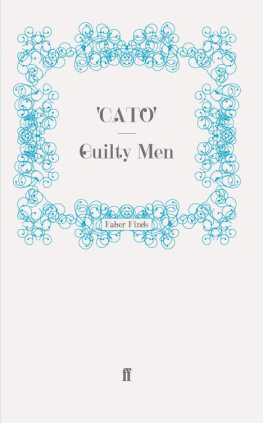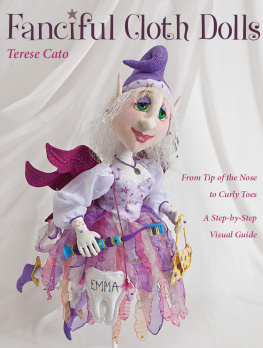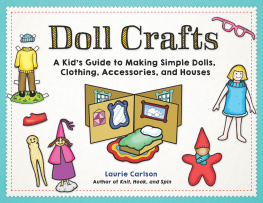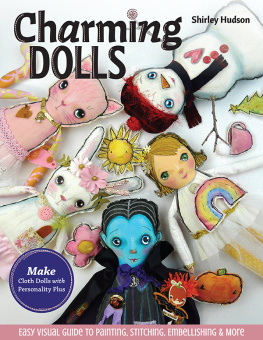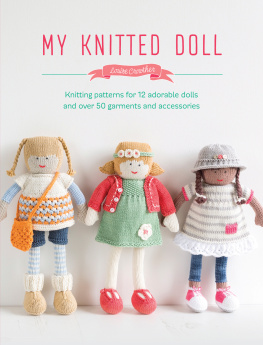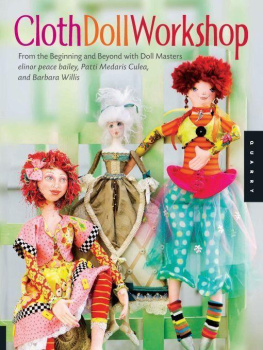
Dedication
For my mother
Preface
Do you have a treasured item that belonged to your grandmother? Perhaps your grandmother gave you something that she treasured because it belonged to her mother. From a tiny trinket to a beautiful quilt that adorns your bed, if the treasured item was actually made by the person it came from, then the sentimental value increases tremendously. The object may have no real monetary value, but it could be priceless to you. We consider these precious gifts to be irreplaceable.
There is a sad-looking angel that decorates my Christmas tree each year. When I say sad, what I really mean is ugly. The fact is that no matter what she looks like, she is very special to me. She has been on the Christmas tree every year since my first Christmas and I wouldnt dream of leaving her off. No one in my family made this angel. She was probably bought at a five-and-ten-cent store. But although she is not much to look at, her beauty is in her sentimental value. She holds many memories for me, so I treat her like a priceless artifact. Between Christmases, shes wrapped in tissue paper and stored in a box where no harm will come to her.
What will you pass on to or leave for your children? Will future generations of your family have something from you to hold dear to their hearts? Why not make something with the deliberate intention of creating a family heirloom? Make something worthy of becoming a prized possession to hold special memories for someone you love.
Many of our family traditions revolve around the holidays we celebrate. The customs we practice as a family remain with us our whole life. Children grow up and continue these traditions with their own families, or at least keep them as fond childhood memories. Sharing these things brings us closer together as a family.
If youre a crafter, then its part of your nature to seek out new projects that include fun techniques. It is my intention to appeal to the crafter, sewer, and quilter in you with the projects in this book. You dont have to be a doll maker to create these projects. If youve never done anything like this before, all you need is a willingness to learn. Ill teach you the techniques and show you all the details. In this book youll find projects that are appropriate for the beginner, the advanced crafter, and everyone in between.
I am granting you an artistic license! With this license you have complete artistic freedom to give each project special touches to make it your own. If you have skills that you enjoyembroidery, beading, quiltingyou can use them to embellish the project with a flair and style that is personally yours.
Doll-Making Basics
The most important tool for making dolls is your imagination, so pull it out and let it run wild. The second most important tool is your sewing machine. Proper routine maintenance may include cleaning, oiling, and lubricatingcheck the instruction booklet for your machine. Some machines are designed to be oil free, so follow the directions for your specific machine. Many problems can be avoided with routine cleaning to remove the lint, dust, and thread that can get into the working parts of a machine. If youve lost your owners manual or bought a used machine that didnt come with one, identify the model, serial number, and age of the machine. Most manufacturers make replacement manuals available on the customer support pages of their websites.
You dont need a fancy sewing machine to create spectacular projects. If you do happen to have a fancy machine, use some of its features wherever you can. Decorative stitching on skirts, sleeves, and pants will add detail that shows you put time and thought into a project.
I get many emails asking, Can I substitute materials? Not only is my answer Yes, but I encourage you to make substitutions. While some types of projects dont allow you to make changes to the original pattern, doll making offers many opportunities to add your personal stamp. If you feel a project pulling you in a different direction, go with it and see where you end up. You can make the same project several times and have unique results each time. The endless possibilities just add to the fun of creating.

I am also asked where I get my inspiration for projects. Its funny, but my ideas often come from what may seem like odd places. A piece of fabric, a color palette, or a prop might define the theme for me, but more often inspiration comes from a strange object that isnt even something Ill use in the project itself. I see something that triggers a memory and gets me thinking. Often these memories are from childhood. I work out all the details in my head before I begin every project. When I can see the finished project clearly in my head, Im ready to bring my idea to life. Once in a while things get changed along the way, but only because the project is leading me in that direction. When Im asked which doll is my favorite, my answer is always the same: Its the one Im working on right now.
I find props around the house, down the street, and across the country. I love to travel, because it broadens my world and my opportunity to go on treasure hunts. My props can be purchased items, but most often they are found objects. My friends often save things they think I might use to make something. Sometimes I find an item thats perfect as is, and other times I find things that I will make into something. I put all these little treasures into a box where they wait to become part of my next project. The patterns in this book are not intended for young children. All the details that make the dolls so special are not safe for children to play with.
General Sewing Equipment
Sewing machine
Open-toe or clear presser foot for sewing on traced lines
Straight pins
Sharp scissors (If youre a quilter, you may find your rotary cutter and acrylic rulers also come in handy.)
Tape measure
All-purpose sewing thread
Quilting thread for attaching body parts and sculpting doll faces
Seam ripper
Needles for hand sewing, including curved needles and 5 and 7 doll-making needles
Iron for pressing doll clothes
General Doll-Making Equipment
Mechanical pencil for tracing templates onto fabric
Fabric marker with disappearing ink
Reverse-action tweezers or hemostat clamp for turning body parts and making fingers (You can find these online, or look for the tweezers in the scrapbooking department of a craft store. While I prefer using the tiny turning tubes for most tasks, including turning the bigger body parts, a pair of reverse-action tweezers will come in handy for guiding a pipe cleaner into a finger. This is a matter of personal preference, so try using whatever you have on hand before buying new tools.)
Tiny turning tubes for turning fingers, body parts, and clothing (see Resources, )
Stuffing tool, such as an unsharpened pencil, a chopstick, or a dowel
Wire cutter for cutting pipe cleaners for fingers


